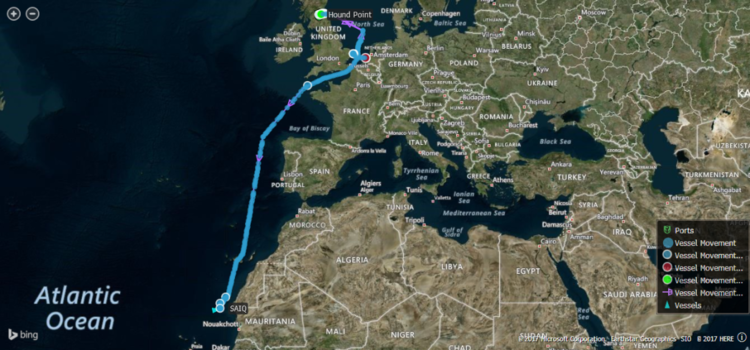
If a single ship can capture the current state of the global oil, it’s the supertanker Saiq, floating idly about 850 kilometers (528 miles) south of the Canary Islands.
Until a few days ago, the 330-meter-long tanker, chartered by Royal Dutch Shell Plc, was steaming at 13 knots toward the Chinese port of Tianjin after loading a two-million-barrel cargo of North Sea oil at the Hound Point terminal near Edinburgh. Then, it suddenly stopped in the middle of the Atlantic Ocean, according to ship-tracking data compiled by Bloomberg.
Its problem: China isn’t buying much crude right now, leaving the tanker searching for a customer. While the vessel was floating near Africa last week, Shell offered to sell the cargo in a ship-to-ship transfer all the way back in Scotland. There weren’t any takers.
Across the world, the plight of the Saiq, now idling off the coast of Mauritania, reflects a broader trend in the physical oil market. After six months of oil-production cuts from the Organization of Petroleum Exporting Countries and 11 non-OPEC nations led by Russia, crude supply is, surprisingly, still plentiful, according to traders.
“It’s a buyer’s market,” said Olivier Jakob, managing director of Swiss-based consultant Petromatrix GmbH, echoing a widely held view in the physical market.
On paper, global supply and demand balances from the likes of the International Energy Agency say the market should be reducing stockpiles. Oil prices, however, suggest that any inventory reduction remains minimal. The headline price for Brent crude, the global benchmark, is below $50 a barrel, indicating buyers are on the sidelines.
Time-spreads, the price difference between contracts for different months, have widened considerably in June, with key yardsticks at levels last seen in November, when OPEC announced its output cuts. Signs have emerged that traders are resorting to turning tankers into floating storage due to a lack of buyers.
Atlantic Glut
The oversupply is particularly acute in the so-called Atlantic basin, where high quality light, sweet crude is abundant due to a combination of factors. They include the return of some Nigerian production following a disruption of more than a year, stronger output from Libya, robust North Sea supplies and record-high U.S. oil exports.
“Recovering output from Nigeria and Libya — which has unexpectedly sustained so far — is worsening the imbalance of light crudes in the market and effectively halving the OPEC cuts,” said Amrita Sen, chief oil analyst at consultant Energy Aspects Ltd. in London. “If OPEC does nothing to compensate for their recovery, light crude prices will remain low,” she added.
Nigerian production is recovering after Shell last week lifted restrictions on shipments of Forcados crude oil, a key export grade, following a disruption that lasted 472 days. The return of Forcados may add as much as 250,000 barrels a day of high quality, light and sweet crude into the Atlantic. While Shell subsequently placed limits on shipments of Nigeria’s Bonny Light crude, the return of Forcados occurs just as regional refiners are awash with similar grades from the U.S., North Sea and Africa.
In Libya, output is near its highest in three years following last week’s restart of the Sharara oil field, the nation’s largest, adding an extra 250,000 barrels a day.
The glut in the Atlantic has been exacerbated by lackluster buying from China, in part because the country’s independent refiners, known as “teapots,” embarked on a buying spree earlier this year. Still, China’s presence in the market could increase. The supertanker Saiq is now signaling another Chinese port as its final destination, though it still appears to be drifting off the African coast. A Shell spokeswoman declined to comment on cargo movements.
Seasonal Demand
The weakness in the Atlantic basin is visible in the widening price difference between Brent crude for delivery in December 2017 and December 2018 — a popular trade often seen as a signal of whether the market is drawing down stocks. The more negative the spread, the larger the oversupply. The spread fell to a 6-month intraday low of minus $1.49 a barrel on June 9, down from plus $1 a barrel two weeks ago. It is now at about minus $1 a barrel.
Other signals point to an oversupply, despite the fact the Atlantic market is entering its strongest season as refiners ramp up crude processing to meet gasoline demand during summer holidays in the U.S. For example, in the North Sea, oil traders have turned seven laden tankers into floating storage facilities while they wait for customers. Sellers in the region have taken to offering crude for ship-to-ship transfer, typically seen as a sign of a bloated market.
In the world of contracts for difference, which allows traders to insure price exposure for their North Sea crude shipments week-by-week, the nearest contract plunged on June 9 to minus $1.29 a barrel, down from 96 cents a week earlier. In the physical market, prices remained at discounts to the Dated Brent price marker as offers for cargoes outstripped bids. Norway’s Ekofisk crude slipped to minus 10 cents, compared with a premium of 20 cents at the beginning of the month.
“This should be the tightest season of the year,” said Petromatrix’s Jakob. “But if you look at physical oil differentials and Brent spreads, its signaling a crude overhang in the Atlantic.”
Recommended for you
